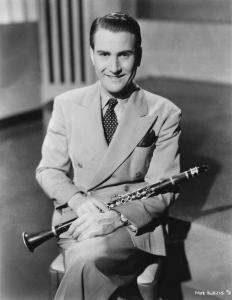Success at Every Turn
Artie Shaw was a unique figure in jazz history. A competitor of Benny Goodman both as a clarinetist and a bandleader, Shaw led no less than seven different orchestras during 1936-49. While he disliked having to play for dancers, was not fond of dealing with the public, and seemed to constantly be running away from fame, he found success at almost every turn, at least until his premature retirement.
Debut
Born Arthur Arshawsky on May 23, 1910 in New York City, he started playing alto saxophone when he was 12 and developed quickly, soon doubling on clarinet. As a young teenager, Shaw played with the New Haven High School Band and led a local group, the Bellevue Ramblers. At 15 he was already skilled enough to go on the road. Among his early associations were groups led by Johnny Cavallaro, Joe Cantor, Merle Jacobs, and Austin Wylie. He made his recording debut in 1930 when he was 20, recording several numbers with a show and comedy dance band, Irving Aaronson’s Commanders: “All By Yourself In The Moonlight“, “If I Had You“, “Why Have You Forgotten Waikiki” and “Moonlight On The Colorado.”
Studio Work
During 1930-34, Shaw primarily worked as a studio musician, making very good money in the worst years of the Depression while performing commercial music that bored him. Other than a few isolated jazz sessions with Fred Rich, Adrian Rollini and Roger Wolfe Kahn, including an appearance with the latter in a 1932 short The Yacht Party which features him playing a hot clarinet solo on “Way Down Yonder In New Orleans,” Shaw toiled anonymously in the background. He became so bored that, having saved up some money, he retired from music for the first time in 1934. Shaw moved to a farm in Bucks County, Pennsylvania and was determined to write a novel. A few months later when he ran out of money, he gave up that dream and returned to the studios.
In 1934 Shaw appeared on a Wingy Manone recording date that also featured Jelly Roll Morton on two songs, recorded with Frank Trumbauer, and was on an all-star swing session led by Red Norvo. During 1935-36 there were records with Trumbauer, the Boswell Sisters, trumpeter Manny Klein, singers Bob Howard and Chick Bullock and a few hot numbers with Bunny Berigan. But as the Swing era began, the clarinetist was still a complete unknown to the public.
New Music
At the last minute, Artie Shaw was hired to fill in for ten minutes at an all-star big band concert held at New York’s Imperial Theatre on May 24, 1936, the day after his 26th birthday. Rather than putting together a large ensemble, he decided to serve as a complete contrast to the parade of big bands. Shaw performed “Interlude In B Flat” with a string quartet and a rhythm section. He was the surprise hit of the night, and had to perform the piece a second time as an encore. Immediately there were calls for him to put together his own group.
Typically Artie Shaw took a radical step and organized Art Shaw and his New Music, an ensemble consisting of trumpet, trombone, his clarinet, tenor, piano, guitar, bass, drums and a string quartet. While the group soon added Lee Castle as a second trumpeter and Tony Pastor took over the tenor spot (supplying friendly vocals), the small orchestra only lasted nine months. Its music was too subtle for many dancers and too quiet for most dance hall owners. Shaw never quite got over its breakup.
Hard Swing
Determined to beat the swing world at its own game, Artie Shaw decided to form a much louder and harder-swinging band. In April 1937 he was at the head of a conventional five-brass, five-reed (counting his clarinet), four-rhythm orchestra. The band played solid music and featured Shaw’s distinctive clarinet but it struggled for a year against the heavy competition. Shaw might have been billed as “King of the Clarinet” but Benny Goodman was still “The King Of Swing.”
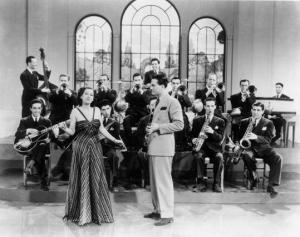
Everything changed when Shaw was signed to the Bluebird label. At his orchestra’s very first Bluebird session on July 24, 1938, they recorded an obscure Cole Porter song, “Begin The Beguine,” that became the most popular record in the country. Suddenly the swing public noticed Artie Shaw. His band, which featured Tony Pastor’s vocals and tenor solos, Billie Holiday (one of the first African-American singers to be featured with a white swing band), tight ensembles, and the leader’s clarinet was considered a sensation. While Holiday (due to conflicts with her record label) was only able to record one song (“Any Old Time”) with Shaw, her successor Helen Forrest became a favorite. “Indian Love Call” (featuring Pastor), “Back Bay Shuffle,” “Nonstop Flight,” “Softly As In A Morning Sunrise” and Shaw’s theme song “Nightmare” were among the many popular numbers. By year-end, the Artie Shaw Orchestra was considered by many to be the #1 swing band. In 1939, with the addition of tenor-saxophonist Georgie Auld and drummer Buddy Rich, the Shaw big band was even more powerful
Hated Celebrity
However becoming a celebrity was not Artie Shaw’s dream. The nonstop schedule of concerts, radio broadcasts, records and film appearances became nerve wracking for him. All he wanted was to perform high-quality music and associate with fellow intellectuals. He hated having to constantly play “Begin The Beguine,” the pressure to perform inferior novelties, signing autographs, interviews with writers who did not understand him, and being recognized everywhere he went.
It all came to a head in Nov. 1939. At an engagement at the Hotel Pennsylvania, Shaw simply left between sets, fleeing to Mexico and leaving his orchestra without a leader. Auld took over for a short time before the second Artie Shaw Orchestra broke up.
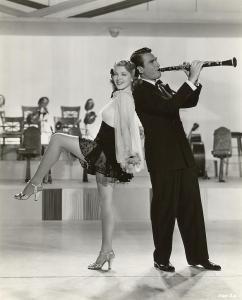
His Way
A few months later, Shaw returned, determined to play music his way. His first recording date, made with a 32-piece orchestra that included 13 strings, resulted in his second biggest hit, “Frenesi.” He just did not seem to be able to avoid success! Having appeared with his band in the 1938 film Dancing Co-Ed, Shaw made his best film appearance in a 1940 Fred Astaire movie Second Chorus that featured him performing “Concerto For Clarinet.”
After the filming was completed, he formed his third orchestra. In addition to ten horns (including trumpeter Billy Butterfield, trombonist Jack Jenney and Jerry Jerome on tenor) and a four-piece rhythm section with pianist Johnny Guarnieri, his new ensemble had nine strings. It became one of the first swing era orchestras to have a string section; many big bands would soon follow, usually with less musical success. Among this orchestra’s finest recordings were what is arguably the all-time greatest instrumental waxing of “Star Dust” (with classic solos by Butterfield, Shaw and Jenney), “Temptation,” and the superb “Concerto For Clarinet.” In addition, Shaw had fun with his Gramercy Five, a sextet that featured Guarnieri on the harpsichord along with Butterfield and the clarinetist. Their recording of “Summit Ridge Drive” became a million seller.
Despite its success (both musically and commercially), Shaw eventually became bored, breaking up the band and taking a vacation. In June, 1941 he led an intriguing record date that teamed him with a large string section and such major black artists as trumpeter Henry “Red” Allen, trombonist J.C. Higginbotham, altoist Benny Carter and Lena Horne. By September he was ready with his fourth orchestra. In addition to the returning Auld, Jenney and Guarnieri, the band had 15 strings, trumpeters Hot Lips Page (who also supplied vocals) and Max Kaminsky, trombonist-arranger Ray Conniff, and drummer Dave Tough. Alternating between classical-inspired works, superior dance music and features for Page, this orchestra had a tremendous amount of potential. Alas, two months after the bombing of Pearl Harbor, Shaw called it quits again and enlisted in the Navy.
The Navy
While in the Navy, Artie Shaw led his fifth orchestra, the U.S. Navy Rangers which included Max Kaminsky, Dave Tough, tenor-saxophonist Sam Donahue and pianist Claude Thornhill. Unfortunately it did not record and, other than an appearance on a radio broadcast (playing, of course “Begin The Beguine”), it was not documented. The orchestra toured the Pacific war theatre where its performances helped raise the morale of troops. Unfortunately Shaw became seriously ill in Dec. 1943, resulting in him begin granted a medical discharge in Feb. 1944.
A few months later, the 34-year old clarinetist was completely recovered and formed his sixth orchestra. With trumpeter Roy Eldridge, trombonist-arranger Ray Conniff, tenor-saxophonist Herbie Steward, pianist Dodo Marmarosa and guitarist Barney Kessel as the key soloists along with Shaw, the band was ready to conquer the swing world even if times were changing. Shaw not only noticed the new bebop music but learned from it, modernizing his style as one can hear on “Easy To Love” (from June 7, 1945) and on combo sides with a new Gramercy Five that featured Eldridge and the rhythm section. Highlights of this band’s recordings include “Lady Day,” “Little Jazz,” and a dramatic Eddie Sauter arrangement of “Summertime.” However, despite Artie Shaw still being a household name, the end of the big band era and a gradual loss of enthusiasm resulted in the clarinetist breaking up the band in early 1946. He continued recording regularly that year, including helping to introduce Mel Torme and the Mel-Tones (their joint recording of “What Is This Thing Called Love” was memorable). But, after fulfilling his recording obligations, for the third time in his life, Artie Shaw retired.
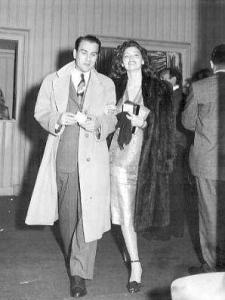
Wives
At this interlude, a little should be mentioned about Artie Shaw’s many wives. Due to his good looks and (by the time of his third wife) his celebrity status, Shaw was considered very attractive to a series of glamorous women. But because of his frequently abrasive personality and being a perfectionist, the marriages usually did not last long. His first two wives, Jean Cairns (1932-33) and Margaret Allen (1934-37), were not from the world of show business. Shaw met Lana Turner when he appeared in her film Dancing Co-Ed but their 1940 marriage only lasted a few months. Next was composer Jerome Kern’s daughter Elizabeth Kern (1942-43) and the famous actress Ava Gardner (1945-46). Kathleen Winsor (1946-48), a novelist who wrote “Forever Amber,” was Mrs. Artie Shaw during his off period. Actresses Doris Dowling (1952-56) and Evelyn Keyes (1957-85) were the last wives. Only Keyes lasted for over four years.
Last Efforts
Artie Shaw spent most of 1947-48 outside of music. He toyed with the idea of becoming a classical clarinetist and in early 1949 appeared at Bop City leading a classical ensemble which completely confused the club’s usual customers.
After giving up that plan, he formed his seventh and final big band, a bop-oriented unit that included trumpeter Don Fagerquist, Al Cohn, and Zoot Sims on tenors, and guitarist Jimmy Raney. Shaw sounded quite modern in his playing, the band was enthusiastic, and its few recordings are rewarding. However this was the only Artie Shaw Orchestra since his very first one to be a commercial flop. The public wanted him to play his old hits the same old way. Shaw threw in the towel after a few months.
During 1950-53, Artie Shaw appeared on an intriguing assortment of records ranging from small group sessions that included trumpeter Lee Castle to string orchestras, Christmas songs, and dates accompanying singers (including Connee Boswell). Other than earning some extra money and keeping his playing chops in shape, Shaw never thought highly of these dates. However starting in Sept. 1953 and continuing through June 1954, he made his final comeback, organizing a new Gramercy Five.
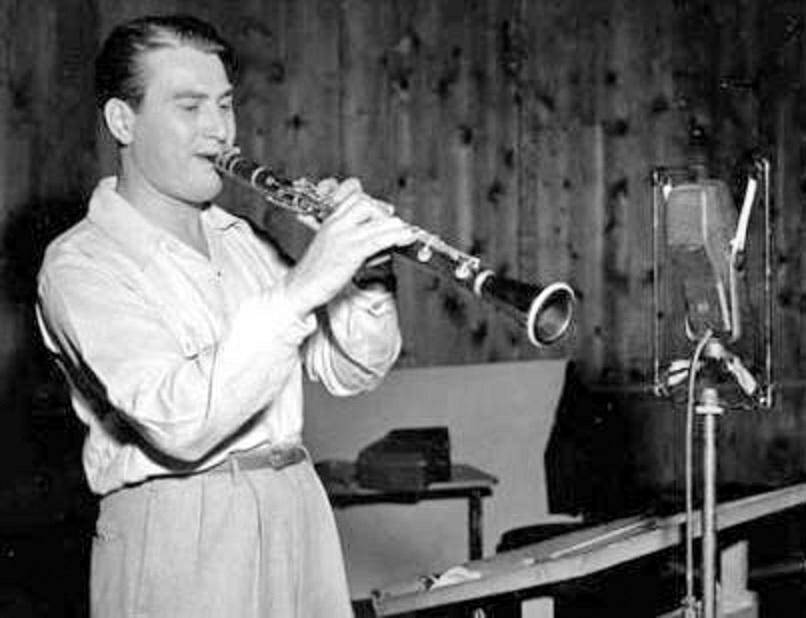 Performing as the only horn and utilizing such players as vibraphonist Joe Roland, pianist Hank Jones, and either Tal Farlow or Joe Puma on guitar, he recorded quite a few numbers for Norman Granz’s Clef label. Performing in clubs with the unit, the still youthful clarinetist showed that he was still very much in his musical prime, playing bop, cool jazz and swing in his own modern style. In fact, in 1954, Shaw still ranks at the top along with (Benny Goodman and Buddy DeFranco) as jazz’s top clarinetist.
Performing as the only horn and utilizing such players as vibraphonist Joe Roland, pianist Hank Jones, and either Tal Farlow or Joe Puma on guitar, he recorded quite a few numbers for Norman Granz’s Clef label. Performing in clubs with the unit, the still youthful clarinetist showed that he was still very much in his musical prime, playing bop, cool jazz and swing in his own modern style. In fact, in 1954, Shaw still ranks at the top along with (Benny Goodman and Buddy DeFranco) as jazz’s top clarinetist.
Long Retirement
But after three prior unsuccessful attempts, he permanently retired at the age of 44, just 18 years after his initial success. Shaw would give conflicting reasons in later years for his decision. Sometimes he said that he was weary of having to play the same old songs (although he generally did not with the final Gramercy Five) or that he felt that he had reached the pinnacle of his playing and wanted to retire on top. Other times he ironically complained that the audiences were not as large as they had been previously, an unintentionally humorous statement from one who had tried so hard to run from fame.
In retrospect, the decision certainly looks like a mistake. Artie Shaw could have had many more musical accomplishments. But instead, his last half-century was spent as a writer with limited success. None of his books or short stories, including his erratic memoirs The Trouble With Cinderella (published in 1952), sold well or are remembered today. A 1,000 page three-volume autobiographical novel (The Education Of Albie Snow) was never published. Shaw was always available to give his opinions on a wide variety of subjects but found that he was constantly asked why he stopped playing clarinet. In later years he relented and led a new Artie Shaw Orchestra but he did not play a note, being satisfied to supervise rehearsals and tell stories on stage.
After seven big bands, eight wives, and 50 years of retirement, the former clarinetist passed away on Dec. 30, 2004 at the age of 94. Despite his decision to stop playing clarinet halfway through his career, it is for his classic music that Artie Shaw will always be remembered.
Since 1975 Scott Yanow has been a regular reviewer of albums in many jazz styles. He has written for many jazz and arts magazines, including JazzTimes, Jazziz, Down Beat, Cadence, CODA, and the Los Angeles Jazz Scene, and was the jazz editor for Record Review. He has written an in-depth biography on Dizzy Gillespie for AllMusic.com. He has authored 11 books on jazz, over 900 liner notes for CDs and over 20,000 reviews of jazz recordings.
Yanow was a contributor to and co-editor of the third edition of the All Music Guide to Jazz. He continues to write for Downbeat, Jazziz, the Los Angeles Jazz Scene, the Jazz Rag, the New York City Jazz Record and other publications.

